INSTITUT SUPERIEUR D'ANTHROPOLOGIE
INSTITUTE OF ANTHROPOLOGY
ONLINE COURSES / COURS A DISTANCE
INSCRIPTIONS OUVERTES
REGISTER NOW
GRECE – 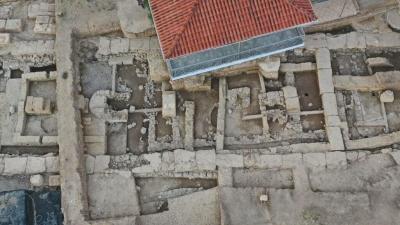 Evia - Last year, a team of 50 archaeologists uncovered an unknown temple near the Temple of Amarysia Artemis on the Greek island of Evia. The majority of the temple dates to the 7th century BC, but archaeologists recently discovered portions of the site that are even older. Inside the temple they found 2,700-year-old altars that seemed to be used often, filled with ash featuring alabaster, vases, jugs, amulets, and jewellery. The temple’s length reaches 100 feet (34 metres) and on its eastern side, the temple preserves a well-constructed wall with a pilaster, while its western side ends in an arch. According to a statement from Greece’s Ministry of Culture, it was built of rough bricks on a foundation of dry stone, which proves that the ground was still swampy at the time of its construction. Along the inner wall, the temple was strengthened by pillars located at regular intervals. The most unique looking design was said to be a horseshoe-shaped altar. It contained thick layers of ash with containments of charred bones. “The possibility that some of them predate the temple cannot be ruled out,” the statement reads. “The first level of use of the horseshoe altar yielded pottery dating to the end of the 8th century BC.” The find didn’t stop at remnants of altars, either. The team of Swiss and Greek researchers found Corinthian alabaster, Attic vases, and locally-made ritual jugs. They also uncovered gold, silver, coral, and amber jewellery, amulets from the East, and bronze and iron fittings. They determined that a portion of the temple was likely destroyed in a fire. This likely led to brick partitions being put in place to protect the remaining sections, and a new section was likely created at the end of the 6th century. Part of the oldest sections, researchers discovered Geometric period bronze figurines representing bulls and a ram. A clay bull head from the Mycenean period was also located on site. “Although the investigation of the earliest of these levels has only just begun, the first discoveries suggest that the cult had its roots in the centuries after the end of the Mycenaean period.”
Evia - Last year, a team of 50 archaeologists uncovered an unknown temple near the Temple of Amarysia Artemis on the Greek island of Evia. The majority of the temple dates to the 7th century BC, but archaeologists recently discovered portions of the site that are even older. Inside the temple they found 2,700-year-old altars that seemed to be used often, filled with ash featuring alabaster, vases, jugs, amulets, and jewellery. The temple’s length reaches 100 feet (34 metres) and on its eastern side, the temple preserves a well-constructed wall with a pilaster, while its western side ends in an arch. According to a statement from Greece’s Ministry of Culture, it was built of rough bricks on a foundation of dry stone, which proves that the ground was still swampy at the time of its construction. Along the inner wall, the temple was strengthened by pillars located at regular intervals. The most unique looking design was said to be a horseshoe-shaped altar. It contained thick layers of ash with containments of charred bones. “The possibility that some of them predate the temple cannot be ruled out,” the statement reads. “The first level of use of the horseshoe altar yielded pottery dating to the end of the 8th century BC.” The find didn’t stop at remnants of altars, either. The team of Swiss and Greek researchers found Corinthian alabaster, Attic vases, and locally-made ritual jugs. They also uncovered gold, silver, coral, and amber jewellery, amulets from the East, and bronze and iron fittings. They determined that a portion of the temple was likely destroyed in a fire. This likely led to brick partitions being put in place to protect the remaining sections, and a new section was likely created at the end of the 6th century. Part of the oldest sections, researchers discovered Geometric period bronze figurines representing bulls and a ram. A clay bull head from the Mycenean period was also located on site. “Although the investigation of the earliest of these levels has only just begun, the first discoveries suggest that the cult had its roots in the centuries after the end of the Mycenaean period.”
https://neoskosmos.com/en/2024/01/22/news/greece/a-rich-discovery-for-researchers-in-greece/
ECOSSE – x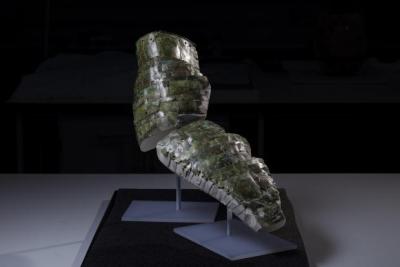 Trimontium - The armour was previously in more than 100 pieces when it was discovered at the Trimontium fort site near Melrose, Scottish Borders, in 1906. Now that all fragments have been reassembled, the arm guard will go on permanent display in the National Museum of Scotland in Edinburgh after the British Museum exhibition ends. Fraser Hunter, principal curator of prehistoric and Roman archaeology at National Museums Scotland, said: “This is an incredibly rare object, and it’s great that this exhibition gave us the opportunity to rebuild it. “The transformation is striking. Now that it’s been reconstructed, you can picture the legionary who once wore it. “It was both protection and status symbol – brass was expensive and would have gleamed like gold on his sword arm. “It offers a vivid connection to this important period when Scotland sat on the Roman Empire’s northern frontier.”“The flexible arm guard is an iconic piece of equipment for Roman gladiators, so it is unusual to see it as a sword arm protection for Roman soldiers too.
Trimontium - The armour was previously in more than 100 pieces when it was discovered at the Trimontium fort site near Melrose, Scottish Borders, in 1906. Now that all fragments have been reassembled, the arm guard will go on permanent display in the National Museum of Scotland in Edinburgh after the British Museum exhibition ends. Fraser Hunter, principal curator of prehistoric and Roman archaeology at National Museums Scotland, said: “This is an incredibly rare object, and it’s great that this exhibition gave us the opportunity to rebuild it. “The transformation is striking. Now that it’s been reconstructed, you can picture the legionary who once wore it. “It was both protection and status symbol – brass was expensive and would have gleamed like gold on his sword arm. “It offers a vivid connection to this important period when Scotland sat on the Roman Empire’s northern frontier.”“The flexible arm guard is an iconic piece of equipment for Roman gladiators, so it is unusual to see it as a sword arm protection for Roman soldiers too.
https://www.thenational.scot/news/24064127.experts-national-museums-scotland-reconstruct-rare-roman-armour/
EGYPTE –  Saqqara - A 16-meter-long (52.5 ft) papyrus was discovered recently in an ancient Egyptian sarcophagus by a team of archaeologists. It is the first complete papyrus text to be found in over a century. The discovery was made in Saqqara, a necropolis that served the ancient city of Memphis as a burial place for the pharaohs and Egyptian royalty. The recently-discovered papyrus dates to about 50 BC, when the Ptolemaic dynasty ruled Egypt. The papyrus contains texts from the Pharaonic Book of the Dead, including magic spells intended to guide the deceased safely through the underworld.
Saqqara - A 16-meter-long (52.5 ft) papyrus was discovered recently in an ancient Egyptian sarcophagus by a team of archaeologists. It is the first complete papyrus text to be found in over a century. The discovery was made in Saqqara, a necropolis that served the ancient city of Memphis as a burial place for the pharaohs and Egyptian royalty. The recently-discovered papyrus dates to about 50 BC, when the Ptolemaic dynasty ruled Egypt. The papyrus contains texts from the Pharaonic Book of the Dead, including magic spells intended to guide the deceased safely through the underworld.
https://greekreporter.com/2024/01/22/16-meter-long-book-dead-ancient-papyrus-egypt-sarcophagus/
BULGARIE – 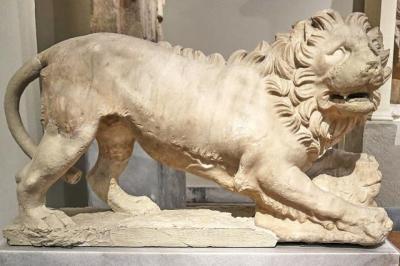 Kozareva - In a captivating revelation, archaeologist Nadezhda Karastoyanova from the National Museum of Natural History, in collaboration with the Bulgarian Academy of Sciences, disclosed the fascinating history of lion hunts on the present-day territory of Bulgaria five millennia ago. "These were indigenous lions that people in prehistory hunted, brought to settlements, and likely consumed," Karastoyanova shared. The Bulgarian lions of that era were apparently similar to their African counterparts, with hypotheses suggesting differences such as smaller manes or even a lack of them. However, at this early stage, the archaeological remains are scarce. Karastoyanova, drawing on her extensive experience, highlighted the diversity in her findings, emphasizing that outcomes varied based on the specific period under scrutiny. Presently, her focus extends to a prehistoric human skeleton discovered at Kozareva Mound in northeastern Bulgaria, near the Black Sea."We suspect the man was likely attacked by a lion, although our research is ongoing," she revealed. Notably, marks on the skull hint at a confrontation with a large predator, aligning with the historical presence of lions in Bulgaria during that timeframe. Remnants of these majestic creatures have been found near Durankulak on the Black Sea coast. One intriguing detail emerges from the ongoing study: the individual not only survived the lion encounter but also remarkably healed from the inflicted wounds. Karastoyanova's work sheds light on a chapter of ancient Bulgaria where humans and lions coexisted, offering a glimpse into a remarkable survival story.
Kozareva - In a captivating revelation, archaeologist Nadezhda Karastoyanova from the National Museum of Natural History, in collaboration with the Bulgarian Academy of Sciences, disclosed the fascinating history of lion hunts on the present-day territory of Bulgaria five millennia ago. "These were indigenous lions that people in prehistory hunted, brought to settlements, and likely consumed," Karastoyanova shared. The Bulgarian lions of that era were apparently similar to their African counterparts, with hypotheses suggesting differences such as smaller manes or even a lack of them. However, at this early stage, the archaeological remains are scarce. Karastoyanova, drawing on her extensive experience, highlighted the diversity in her findings, emphasizing that outcomes varied based on the specific period under scrutiny. Presently, her focus extends to a prehistoric human skeleton discovered at Kozareva Mound in northeastern Bulgaria, near the Black Sea."We suspect the man was likely attacked by a lion, although our research is ongoing," she revealed. Notably, marks on the skull hint at a confrontation with a large predator, aligning with the historical presence of lions in Bulgaria during that timeframe. Remnants of these majestic creatures have been found near Durankulak on the Black Sea coast. One intriguing detail emerges from the ongoing study: the individual not only survived the lion encounter but also remarkably healed from the inflicted wounds. Karastoyanova's work sheds light on a chapter of ancient Bulgaria where humans and lions coexisted, offering a glimpse into a remarkable survival story.
https://www.novinite.com/articles/223698/Archaeological+Marvel%3A+Lions+Hunted+in+Bulgaria+5%2C000+Years+Ago
CHINE – 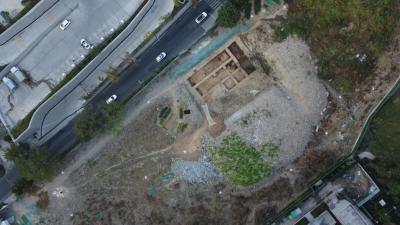 Hangzhou -Two archaeological sites have been unearthed in Hangzhou City, capital of east China's Zhejiang Province, shedding light on stone processing dating back to the Liangzhu civilization around 5,000 years ago, according to a meeting on the province's archaeological work that concluded on Sunday. The two relic sites are the Shenjiali relic site in the city's Xiaoshan District and the Shenjiafan relic site in Tonglu County. The Shenjiali relic site, spanning approximately 15,000 square meters with an excavated area of 325 square meters, revealed the remains of a sophisticated stone processing plant from the Liangzhu culture, where archaeologists uncovered tens of thousands of stone processing by-products. "The Shenjiali site is close to mountains, where stonemasons had direct access to extract stones. These artisans held high standards, evident in the archaeological findings that showcase many well-executed semifinished stone grinding artifacts," said Li Wei, associate researcher of the Department of Cultural Heritage and Museology at Fudan University. The Shenjiafan site, covering around 40,000 square meters with an excavated area of 1,500 square meters, has revealed over 200 sites, including ash pits, tombs, column pits, and stone hedges. The excavation has also yielded 37,000 relics, predominantly stone products from the Liangzhu civilization. These artifacts encompass various stages of stoneware alongside raw materials and tools, said Guan Xinyu, the site's executive leader, adding that the site once functioned as a sizable stone processing area. The new findings not only provide archaeological evidence for understanding the origin of stone tools in the Liangzhu civilization but also contribute to the overall analysis and research of the production and circulation of stone tools within this ancient civilization, said Wang Ningyuan, an expert at the Zhejiang Provincial Institute of Cultural Relics and Archaeology.
Hangzhou -Two archaeological sites have been unearthed in Hangzhou City, capital of east China's Zhejiang Province, shedding light on stone processing dating back to the Liangzhu civilization around 5,000 years ago, according to a meeting on the province's archaeological work that concluded on Sunday. The two relic sites are the Shenjiali relic site in the city's Xiaoshan District and the Shenjiafan relic site in Tonglu County. The Shenjiali relic site, spanning approximately 15,000 square meters with an excavated area of 325 square meters, revealed the remains of a sophisticated stone processing plant from the Liangzhu culture, where archaeologists uncovered tens of thousands of stone processing by-products. "The Shenjiali site is close to mountains, where stonemasons had direct access to extract stones. These artisans held high standards, evident in the archaeological findings that showcase many well-executed semifinished stone grinding artifacts," said Li Wei, associate researcher of the Department of Cultural Heritage and Museology at Fudan University. The Shenjiafan site, covering around 40,000 square meters with an excavated area of 1,500 square meters, has revealed over 200 sites, including ash pits, tombs, column pits, and stone hedges. The excavation has also yielded 37,000 relics, predominantly stone products from the Liangzhu civilization. These artifacts encompass various stages of stoneware alongside raw materials and tools, said Guan Xinyu, the site's executive leader, adding that the site once functioned as a sizable stone processing area. The new findings not only provide archaeological evidence for understanding the origin of stone tools in the Liangzhu civilization but also contribute to the overall analysis and research of the production and circulation of stone tools within this ancient civilization, said Wang Ningyuan, an expert at the Zhejiang Provincial Institute of Cultural Relics and Archaeology.
https://news.cgtn.com/news/2024-01-22/New-findings-show-stone-processing-practices-of-Liangzhu-civilization-1qz2OBByAuc/p.html
CHINE – Jinyang - Hand gestures resembling the modern-day victory sign in murals adorning a recently unearthed Tang Dynasty (618-907) tomb have sparked curiosity among archaeologists and visitors alike. The Archaeological Museum of Jinyang Ancient City in Taiyuan, Shanxi province, unveiled the well-preserved brick chamber tomb of Guo Xing on Friday. Dating back over 1,300 years, it's the first public display of this accidental discovery from 2019. Guo Xing, a Tang Dynasty military officer under Emperor Taizong, Li Shimin (599-649), rests alongside his wife within the tomb. Exquisite murals adorn the chamber walls, ceiling, door, and even the coffin. Intriguingly, some figures in the murals raise their index and middle fingers, with the remaining fingers curled, in a gesture remarkably similar to the modern-day victory sign. However, the meaning behind this pose remains ambiguous. Pei Jingrong, head of the Taiyuan Institute of Archaeology, told China Central Television that while some interpret it as a blessing, a definitive explanation eludes the academic community. The newly unveiled tomb adds another layer of cultural richness to the museum, which stands within the ancient city of Jinyang, whose history stretches back to the Spring and Autumn Period (770-476 BC). As a thematic museum, it delves deep into the history and culture of this ancient metropolis.
http://www.china.org.cn/arts/2024-01/22/content_116955681.htm
CHINE –  Shiyu - A multinational team of researchers have published a new paper in the journal Nature Ecology & Evolution, presenting findings that indicate the existence of an advanced material culture in China around 45,000 years ago. The paper centres on the Shiyu Upper Palaeolithic site in Shanxi Province, where previous archaeological excavations during the 1960’s uncovered evidence of human occupation in the lower context layers. Among the discoveries were more than 15,000 stone tools, numerous animal remains, and a fragment of a hominid skull, identified as belonging to the Homo sapiens species. Part of this archaeological assemblage was relocated to the Institute of Vertebrate Palaeontology and Palaeoanthropology in Beijing, however, the remaining materials, including the cranial fragment, were lost when left in local facilities.Under the direction of Dr. Shixia Yang, the researchers examined the remaining assemblage by using modern radiometric techniques that enabled them to accurately establish the chronological timeline. The results of their study revealed that the cultural layer at Shiyu dates to a period between 45,800 and 43,200 years ago. According to the study authors, the finding provides new information to understand the expansion of Homo sapiens on the Asian continent and the arrival of the first modern humans in northern China. In addition, the type of material culture that the first settlers utilised. According to Professor Yang, “This is an Early Upper Palaeolithic assemblage, which includes laminar technology, but also Levallois points, projectile points with evidence of handling and impact fractures, tools made with obsidian from hundreds of kilometres of distance, projectile points made of animal bone, as well as a small perforated graphite disk.” The material culture indicates that these early settlers had a capacity to supply themselves with resources from large distances and use a cultural hybridization of materials to gain a technological advantage.
Shiyu - A multinational team of researchers have published a new paper in the journal Nature Ecology & Evolution, presenting findings that indicate the existence of an advanced material culture in China around 45,000 years ago. The paper centres on the Shiyu Upper Palaeolithic site in Shanxi Province, where previous archaeological excavations during the 1960’s uncovered evidence of human occupation in the lower context layers. Among the discoveries were more than 15,000 stone tools, numerous animal remains, and a fragment of a hominid skull, identified as belonging to the Homo sapiens species. Part of this archaeological assemblage was relocated to the Institute of Vertebrate Palaeontology and Palaeoanthropology in Beijing, however, the remaining materials, including the cranial fragment, were lost when left in local facilities.Under the direction of Dr. Shixia Yang, the researchers examined the remaining assemblage by using modern radiometric techniques that enabled them to accurately establish the chronological timeline. The results of their study revealed that the cultural layer at Shiyu dates to a period between 45,800 and 43,200 years ago. According to the study authors, the finding provides new information to understand the expansion of Homo sapiens on the Asian continent and the arrival of the first modern humans in northern China. In addition, the type of material culture that the first settlers utilised. According to Professor Yang, “This is an Early Upper Palaeolithic assemblage, which includes laminar technology, but also Levallois points, projectile points with evidence of handling and impact fractures, tools made with obsidian from hundreds of kilometres of distance, projectile points made of animal bone, as well as a small perforated graphite disk.” The material culture indicates that these early settlers had a capacity to supply themselves with resources from large distances and use a cultural hybridization of materials to gain a technological advantage.
https://www.heritagedaily.com/2024/01/researchers-find-evidence-of-an-advanced-material-culture-45000-years-ago/150297
POLOGNE – 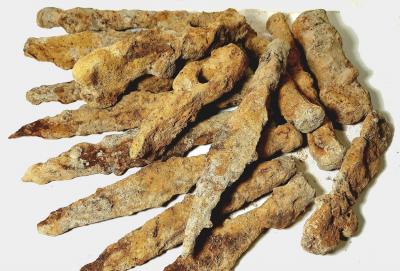
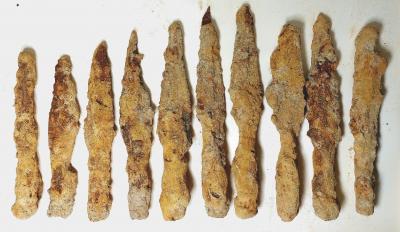 Hrubieszów - The Lublin Provincial Monuments Conservator has announced the discovery of an assemblage of “Barbarian” weaponry in the State Forests in the Hrubieszów region of Poland. According to the announcement, the assemblage dates to the Roman period and may be associated with the Przeworsk culture, an Iron Age people that emerged in the upper Oder and Vistula basins during the 3rd century BC, and continued to inhabit central and southern Poland until the 5th century AD. The culture’s decline in the late 5th century coincides with the invasion of the Huns and the social crisis that occurred as a result of the collapse of the Roman world. Most of the metal objects are made from corroded iron and were found at one discovery site in a shallow context. Archaeologists have so far identified two iron battle axes, two iron chisels, a dozen iron spear heads, and one blade axe likely used in carpentry. “The number of artefacts, their nature, method of deposit, and state of their preservation, exclude the possibility of a cemetery or a single burial, as no bones or fragments of pottery were found to indicate a grave pit”, said the Lublin Provincial Monuments Conservator on social media. “We are most likely dealing with weapons used by barbaric tribes during the Roman period”, also noting that previous excavations in the vicinity have uncovered a Przeworsk warrior burial at Horodło. Alternative hypotheses propose a potential connection of the assemblage with Gothic cultures or the Vandals. However, without a thorough investigation, the precise nature of the discovery and its chronological and cultural affiliation remains speculative at present. Archaeologists plan to return to the discovery site in Spring to conduct a thorough archaeological inspection.
Hrubieszów - The Lublin Provincial Monuments Conservator has announced the discovery of an assemblage of “Barbarian” weaponry in the State Forests in the Hrubieszów region of Poland. According to the announcement, the assemblage dates to the Roman period and may be associated with the Przeworsk culture, an Iron Age people that emerged in the upper Oder and Vistula basins during the 3rd century BC, and continued to inhabit central and southern Poland until the 5th century AD. The culture’s decline in the late 5th century coincides with the invasion of the Huns and the social crisis that occurred as a result of the collapse of the Roman world. Most of the metal objects are made from corroded iron and were found at one discovery site in a shallow context. Archaeologists have so far identified two iron battle axes, two iron chisels, a dozen iron spear heads, and one blade axe likely used in carpentry. “The number of artefacts, their nature, method of deposit, and state of their preservation, exclude the possibility of a cemetery or a single burial, as no bones or fragments of pottery were found to indicate a grave pit”, said the Lublin Provincial Monuments Conservator on social media. “We are most likely dealing with weapons used by barbaric tribes during the Roman period”, also noting that previous excavations in the vicinity have uncovered a Przeworsk warrior burial at Horodło. Alternative hypotheses propose a potential connection of the assemblage with Gothic cultures or the Vandals. However, without a thorough investigation, the precise nature of the discovery and its chronological and cultural affiliation remains speculative at present. Archaeologists plan to return to the discovery site in Spring to conduct a thorough archaeological inspection.
https://www.heritagedaily.com/2024/01/barbarian-weapons-assemblage-discovered-in-hrubieszow-state-forests/150290
FRANCE – 
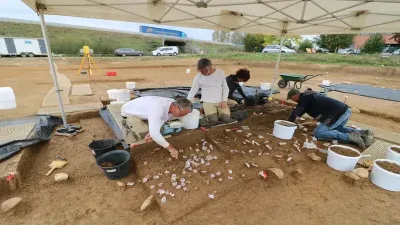 Fragnes-La-Loyère - C'est une découverte exceptionnelle, et inattendue.x Dans le cadre de la construction d'une bretelle d'autoroute, un chantier archéologique s'est installé près de Fragnes-La-Loyère (Saôe-et-Loire). C'est dans ce contexte que, fin 2023, l'institut national de recherches archéologiques préventives (Inrap) de Bourgogne Franche-Comté pose ses valises dans cette zone au nord de Chalon-sur-Saône. Et le jeu en valait la chandelle. Les archéologues ont découvert 4 000 objets, et une centaine d'outils de chasse de la Préhistoire. "Ces objets sont des pointes à face plane. Ce sont des objets très rares à l’échelle nationale. Des sites comme celui-là se comptent sur les doigts d’une main en France", précise Jean-Baptiste Lajoux, responsable d'opérations et spécialiste des périodes paléolithiques. Ces objets proviennent du Paléolithique supérieur, entre 23 000 et 22 000 avant notre ère. Le site a été occupé au cours de la période solutréenne, dans sa phase ancienne, au moment de la période glaciaire. "La population a occupé ce site sur une période assez courte, quelques jours ou semaines, avec un outillage assez peu diversifié. Le site avait une vocation particulière, un campement de chasse ou de traitement des carcasses d’animaux." Sur une surface d’à peine 40 m², les archéologues de l’Inrap ont extrait près de 4 000 objets dans un état de conservation exceptionnel, alors qu’ils ne reposaient qu’à 50 centimètres sous terre. La fouille vient de se terminer, et la phase d'études peut désormais commencer. "On connaît très mal les phases anciennes du Solutréen, donc c’est une découverte importante. On va voir si ça servait de couteau ou d'un autre usage. On va devoir les étudier, et déterminer si ça a servi à découper de la viande, ou servi d’armes de chasse", annonce Jean-Baptiste Lajoux. Christophe Bontemps est technicien de fouille à l’Inrap. Lorsqu'il est tombé sur l'objet, il a directement su qu'il venait de faire une découverte. "On a tout de suite compris que c’était une pointe à face planche. "On a encore envie de continuer. On sait très bien qu'à quelques centimètres, on peut faire une autre découverte", poursuit Christophe Bontemps. "Lorsqu'on trouve des objets rares en très bel état, on est forcément très excités par ce travail." Ces lames vont faire l'objet d’un rapport, et probablement d'une publication scientifique.
Fragnes-La-Loyère - C'est une découverte exceptionnelle, et inattendue.x Dans le cadre de la construction d'une bretelle d'autoroute, un chantier archéologique s'est installé près de Fragnes-La-Loyère (Saôe-et-Loire). C'est dans ce contexte que, fin 2023, l'institut national de recherches archéologiques préventives (Inrap) de Bourgogne Franche-Comté pose ses valises dans cette zone au nord de Chalon-sur-Saône. Et le jeu en valait la chandelle. Les archéologues ont découvert 4 000 objets, et une centaine d'outils de chasse de la Préhistoire. "Ces objets sont des pointes à face plane. Ce sont des objets très rares à l’échelle nationale. Des sites comme celui-là se comptent sur les doigts d’une main en France", précise Jean-Baptiste Lajoux, responsable d'opérations et spécialiste des périodes paléolithiques. Ces objets proviennent du Paléolithique supérieur, entre 23 000 et 22 000 avant notre ère. Le site a été occupé au cours de la période solutréenne, dans sa phase ancienne, au moment de la période glaciaire. "La population a occupé ce site sur une période assez courte, quelques jours ou semaines, avec un outillage assez peu diversifié. Le site avait une vocation particulière, un campement de chasse ou de traitement des carcasses d’animaux." Sur une surface d’à peine 40 m², les archéologues de l’Inrap ont extrait près de 4 000 objets dans un état de conservation exceptionnel, alors qu’ils ne reposaient qu’à 50 centimètres sous terre. La fouille vient de se terminer, et la phase d'études peut désormais commencer. "On connaît très mal les phases anciennes du Solutréen, donc c’est une découverte importante. On va voir si ça servait de couteau ou d'un autre usage. On va devoir les étudier, et déterminer si ça a servi à découper de la viande, ou servi d’armes de chasse", annonce Jean-Baptiste Lajoux. Christophe Bontemps est technicien de fouille à l’Inrap. Lorsqu'il est tombé sur l'objet, il a directement su qu'il venait de faire une découverte. "On a tout de suite compris que c’était une pointe à face planche. "On a encore envie de continuer. On sait très bien qu'à quelques centimètres, on peut faire une autre découverte", poursuit Christophe Bontemps. "Lorsqu'on trouve des objets rares en très bel état, on est forcément très excités par ce travail." Ces lames vont faire l'objet d’un rapport, et probablement d'une publication scientifique.
https://france3-regions.francetvinfo.fr/bourgogne-franche-comte/saone-et-loire/100-outils-de-chasse-vieux-de-20-000-ans-des-archeologues-font-une-decouverte-rare-en-saone-et-loire-2909699.html